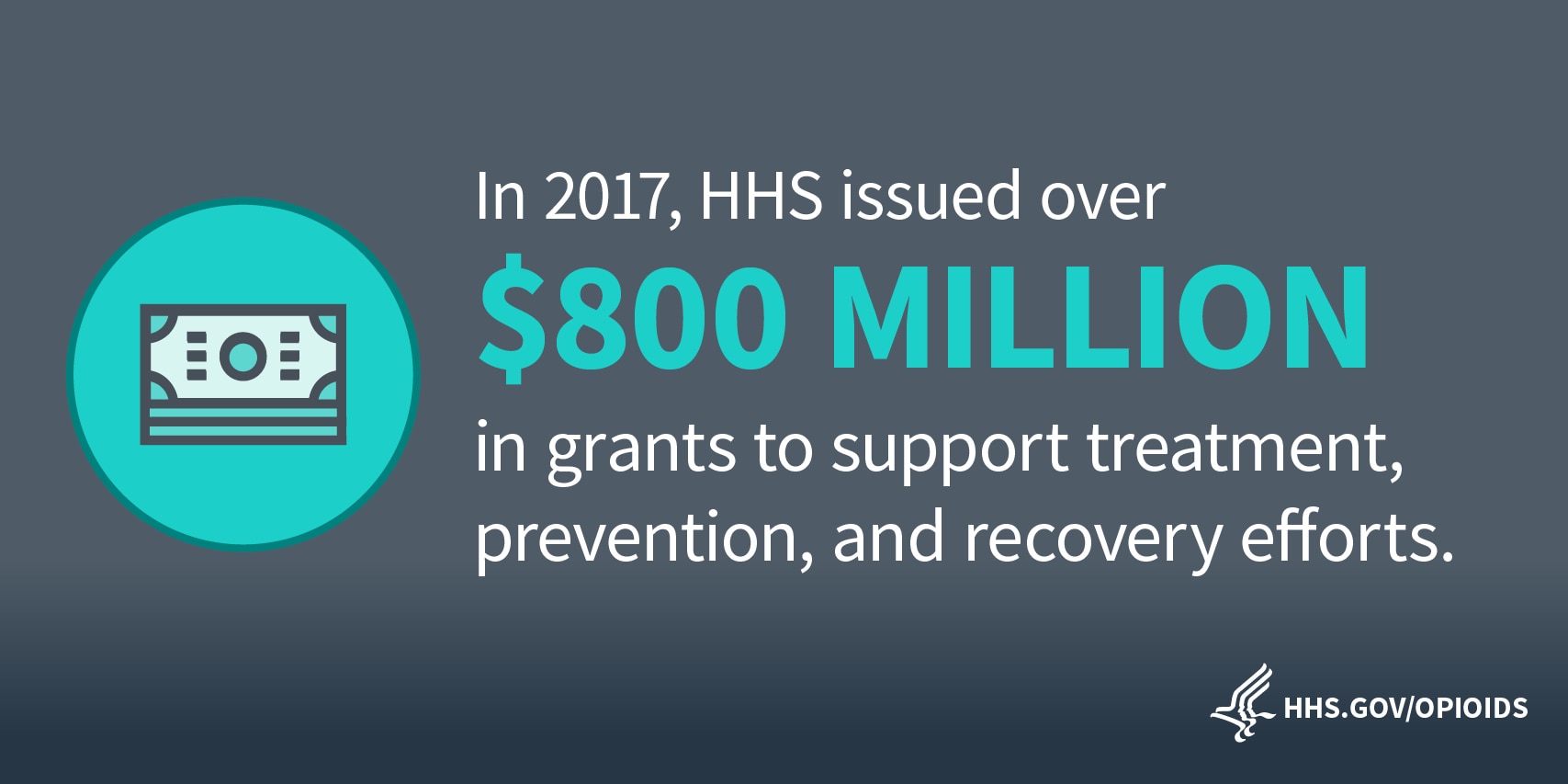Better Prevention, Treatment & Recovery Services
![]() In 2017, HHS issued over $800 million in grants to support access to opioid-related treatment, prevention, and recovery, while making it easier for states to receive waivers to cover treatment through their Medicaid programs. The Department also published resources and media materials to raise awareness of the epidemic and efforts to prevent its escalation.
In 2017, HHS issued over $800 million in grants to support access to opioid-related treatment, prevention, and recovery, while making it easier for states to receive waivers to cover treatment through their Medicaid programs. The Department also published resources and media materials to raise awareness of the epidemic and efforts to prevent its escalation.

HHS awarded the $1B Opioid State Targeted Response (STR) grant funding allocation to states and territories to help combat opioid addiction. The funding was allocated over two rounds in FY2017 and FY2018 as provided for in the 21st Century Cures Act.
In September 2017, SAMHSA awarded $144 million in grants to support opioid and other efforts to combat substance abuse across the country.
- First Responders – Comprehensive Addiction and Recovery Act - $44.7 million. The purpose of this program is to provide training and medication for emergency treatment of opioid overdose.
- State Pilot Grant for Treatment of Pregnant and Postpartum Women - Comprehensive Addiction and Recovery Act - $9.8 million. The purpose of the program is to support family-based services for pregnant and postpartum women with a primary diagnosis of a substance use disorder, including opioid use disorders.
- Building Communities of Recovery - Comprehensive Addiction and Recovery Act - $4.6 million. The purpose of this program is to increase the availability of long-term recovery support for substance abuse and addiction.
- Improving Access to Overdose Treatment - Comprehensive Addiction and Recovery Act - $1 million. The purpose of this program is to expand access to FDA-approved drugs or devices for emergency treatment of opioid overdose.
- Targeted Capacity Expansion: Medication Assisted Treatment (MAT) – Prescription Drug and Opioid Addiction - $35 million. The purpose of this program is to expand access to medication-assisted treatment for persons with an opioid use disorder seeking treatment.
- Services Grant Program for Residential Treatment for Pregnant and Postpartum Women - $49 million. The purpose of this program is to expand services for women and their children in residential substance abuse treatment facilities, among other services.
In September 2017, HRSA awarded $200 million to health centers nationwide to tackle mental health and fight the opioid overdose crisis including nearly $4.2 million in grants to 34 rural health organizations to increase access to treatment and recovery services for opioid abuse in rural communities. HRSA also supported the creation of the Rural Prevention and Treatment of Substance Abuse Toolkit containing model programs and program sustainability strategies.
The Office on Women’s Health (OWH) has awarded cooperative agreement grants totaling $2 million to public and private nonprofit entities across 15 states to address the primary and/or secondary prevention
ACF awarded a $7.8 million contract for a new project to evaluate and support states in implementing promising initiatives assisting members of families receiving Temporary Assistance for Needy Families (TANF) in overcoming opioid use disorder, other substance use disorders, or serious mental illness, so that they are able to enter the workforce and ultimately achieve self-sufficiency.
In July 2017, the Office on Women’s Health (OWH) awarded cooperative agreement grants totaling $2 million to public and private nonprofit entities across 15 states to address the primary and/or secondary prevention of prescription and illegal opioid misuse by women across the lifespan.
CDC launched the Rx Awareness Campaign, a large, extensively tested multimedia campaign to increase awareness and knowledge about the risks associated with prescription opioids and to prevent their misuse.
AHRQ published a report that describes the essential features of successful models of medication-assisted treatment for primary care and examines factors that may limit access to treatment for opioid use disorder in rural primary care settings. The report also includes links and descriptions to nearly 250 tools and resources to support the delivery of medication-assisted treatment in rural primary care settings.
SAMHSA’s revised “Mandatory Guidelines for Federal Workplace Drug Testing Using Urine” went into effect on October 1, 2017, updated to include the authority to test for four semi-synthetic opioids: oxycodone, oxymorphone, hydrocodone, and hydromorphone.
CMS announced a bold new waiver/demonstration policy that increases the flexibility for states to apply for new funding/expenditure authority to address one of the biggest barriers to treatment: the decades old statutory requirement that prohibits Medicaid from paying for inpatient or residential addiction treatment at facilities with more than 16 treatment slots.
OCR published guidance to ensure that healthcare providers understand their broad ability to share information with patients’ family members during crisis situations, such as drug overdoses, without violating HIPAA.
The Center for Faith-Based and Neighborhood Partnerships created a “toolkit” designed to equip local communities—lay persons, faith groups, non-profits, and health care providers—with practical steps they can take to bring hope and healing to the millions suffering the consequences of opioid abuse.
Section 7 of the National Action Plan for Adverse Drug Event Prevention addresses opioids and includes implementation strategies that are expected to result in safer and higher quality health care services, reduced health care costs, informed and engaged consumers, and, ultimately, improved health outcomes.
